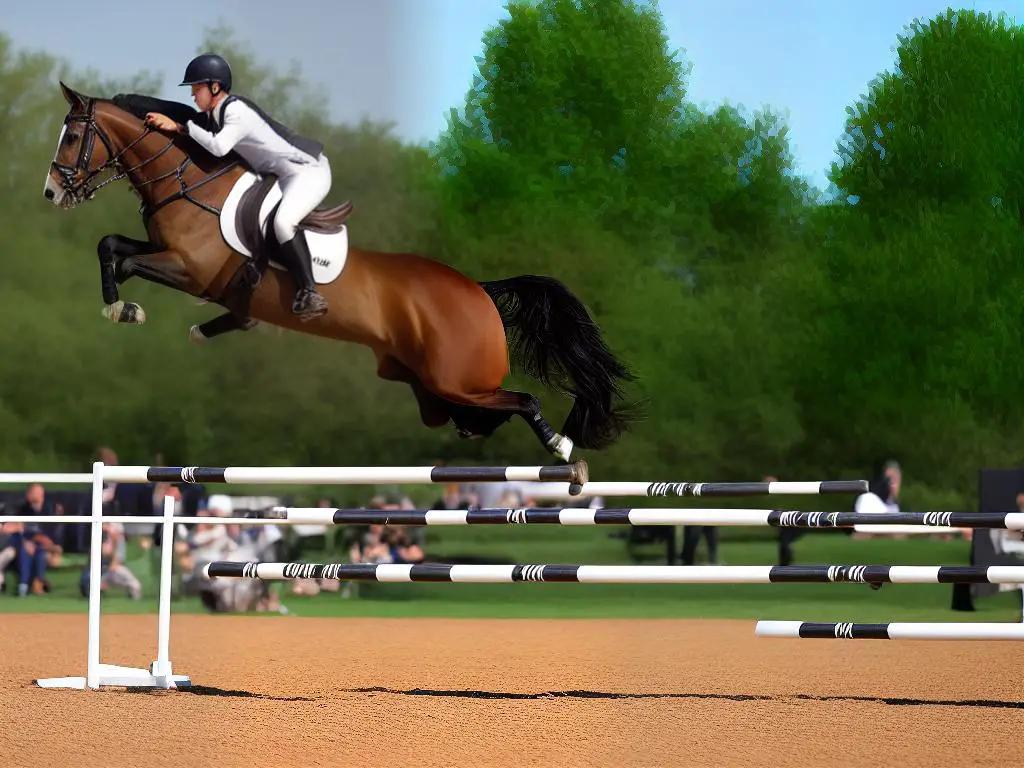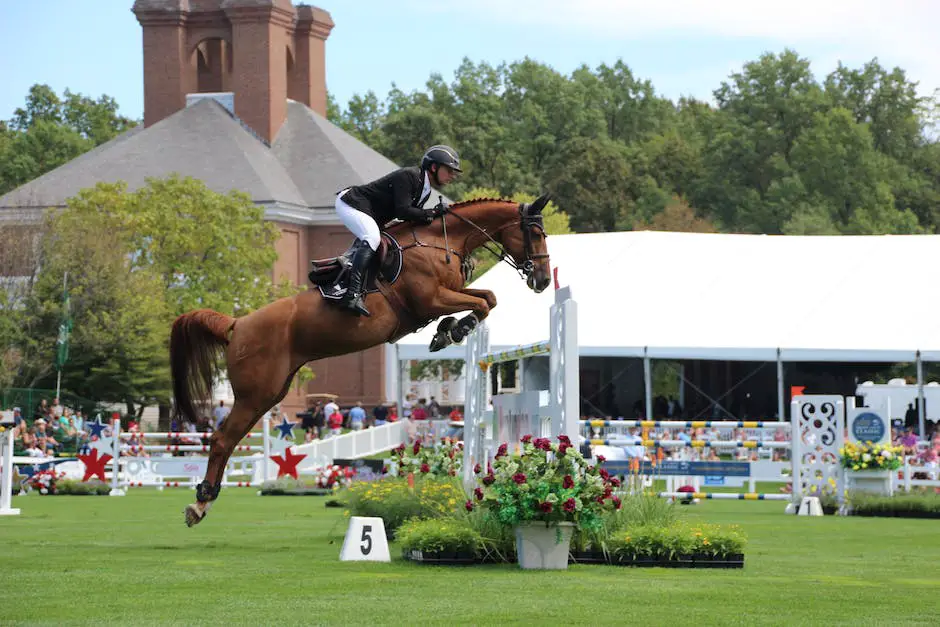Warmblood sport horses have long captivated the equestrian world with their distinct physical attributes, temperaments, and superior athletic prowess. Bred for performance, these horses display remarkable agility, speed, and stamina, traits that set them apart from the rest. Their selective breeding process over centuries has resulted in diverse and refined breeds, each with unique properties. Renowned breeds such as the Hanoverians, Selle Français, and Dutch Warmbloods, each come with their specialities and attributes, offering an interesting study about selective breeding practices.
Table of Contents (Horspedia)
Unique Traits of Warmblood Sport Horses
Warmblood Sport Horses
Warmblood sport horses are a unique group of mid-sized horse breeds that are extremely popular in the equestrian world. Originally developed in Europe, these breeds have unique traits that make them ideal for a variety of equestrian disciplines, including dressage, show jumping, and eventing. Due to the combination of their size, temperament, lifespan, durability, speed, agility, and stamina, they are the go-to choice for many serious equestrians and professional riders.
Physical Characteristics
Warmbloods typically stand between 15.2 and 17.2 hands high. This medium size makes them sturdy and durable while still being agile and athletic. They are not as heavily muscled as draft horses, yet they are sturdier and larger-boned than most light horse breeds. Their build is often characterized by a long, sloping shoulder, strong hindquarters, substantial bone structure, deep chest, and often, a rectangular frame. Their heads are well-proportioned with expressive eyes and wide nostrils, and their necks are usually medium-length and set high.
Behavioral Characteristics
Warmbloods are specifically bred for their calm, even-tempered disposition. This gentleness and willingness to learn make them excellent companions and work horses. They are often described as “warm,” meaning they are friendly, patient, and sociable. These horses are easy to handle and train, making them a favorite among both amateur and professional riders. Their steady, calm temperament doesn’t mean they lack spirit or willingness to work, though. Equally important, they display a remarkable combination of both courage and sensitivity.
Durability and Lifespan
Warmbloods are a hardy breed with a lifespan typically ranging between 15 to 25 years, although many horses exceed this with proper care and maintenance. Unlike some other breeds, they require an active lifestyle to maintain good health. They have strong, durable hooves and a robust immune system, keeping them healthier and in the competition circuit for longer. Their skeletons are also denser than many other breeds, which makes them less prone to injury.
Athletic Performance
The outstanding athletic prowess of Warmblood sport horses is largely due to their unique combination of stamina, strength, and agility. Their power is most effectively demonstrated in the equestrian sports of dressage, show jumping, and eventing, where the horse’s athleticism and obedience to the rider are rigorously tested. Warmbloods often exhibit an innate aptitude for performing movements with grace and precision in dressage, excelling with their exceptional balance, flexibility, and muscular development. In show jumping, their strength, agility, and attentiveness make them strong contenders, often able to clear high and complex obstacles with ease.
Speed, Agility, and Stamina
While they may not be the fastest in short sprints compared to breeds like Thoroughbreds, Warmbloods are often admired for their sustained speed and stamina that make them superior in equestrian sports and events that require more than just speed, such as eventing that challenges both the horse’s ability to speed, jump, and perform dressage routines. Their agility is another factor that sets them apart, with many individuals demonstrating a natural ability to adjust stride, turn sharply, and maintain balance even over complex terrain or tricky obstacles.
Introduction
Warmblood sport horses distinguish themselves from other breeds with their impressive physical attributes and well-balanced temperament. Their relatively moderate size makes them an ideal choice for all riders, being large enough to carry an adult rider yet maintaining enough flexibility and grace due to their smaller stature. What sets them apart is the rare combination of a docile nature, strength, agility, and endurance. This blend of qualities makes Warmbloods a preferred option for all levels of riders, offering a perfect blend of majestic power and poised elegance.

Breeding and Development of Warmblood Horses
Characteristics of Warmblood Sport Horses
Internationally recognized for their elegant movement, athleticism, and fierce competitive spirit, Warmblood sport horses have been refined over centuries through careful breeding practices. These horses usually feature in significant equestrian disciplines such as dressage, showjumping, and eventing, embodying the epitome of equine power and grace. Breeds in this category include renowned names like the Dutch Warmbloods, Hanoverians, and Selle Français. Each breed boasts distinct traits and characteristics shaped and preserved by rigorous selective breeding methods.
The Evolution of Warmblood Breeds
Tracing the origins of Warmblood horses takes us back to medieval Europe, where the necessity for war horses prompted the establishment of selective breeding programs. During the early centuries, Warmbloods were bred to be war steeds, known for their strength, endurance, and mountable size. However, with the advent of modern warfare, the need for war horses diminished. As a result, breeders shifted their focus towards developing breeds suited for agriculture and transportation. The dawn of the 20th century saw a resurgence in the demand for sport horses, prompting a fresh direction in warmblood breeding – the development of the horses perfect for sports and competitions.
Distinguishing between different Warmblood Breeds
Even though many Warmblood breeds share common roots and attributes, the various breeds are distinct in their own ways. One of the most renowned breeds, Hanoverians, are highly valued for their versatility, athletic ability, and even temperament, making them a preferred breed for Olympic-level equestrian competitions. Dutch Warmbloods, produced by the Royal Dutch Sport Horse, are carefully bred for dressage, showjumping, and driving. They are known for their powerful movements, sturdiness, and calm demeanor. The Selle Français, a versatile French breed, is renowned for its jumping ability, agility, speed, and courage, making them prominent competitors in international showjumping and eventing.
Selective Breeding & Quality Control
A cornerstone of warmblood breeding is the strict selection process that each prospective breeding horse must pass through. Unlike closed-studbook breeds, where pedigree is paramount, Warmblood breeds operate on a performance-driven basis. Prospective breeding horses undergo rigorous testing for conformation, movement, and temperament before they are accepted into the studbook. This quality control ensures that only the highest-quality individuals contribute to the next generation, thereby preserving and enhancing the distinctive attributes of each breed.
The Modern-Day Warmblood Sport Horse
Today, the focus on selective breeding has culminated in the development of the modern warmblood sport horse – a combination of power, endurance, agility, and temperament. These horses embody the best traits of their ancestors, juxtaposed with modern dressage and showjumping requirements. They are high-performing athletes, known for their impressive abilities in equestrian competitions worldwide.
Warmblood Sport Horse Breeding Today
Warmblood sport horse breeding is rich in history, brimming with science, and infused with artistry. Over the centuries, principals of retaining the finest attributes while enhancing any weaknesses have resulted in some of today’s most admirable horse breeds. Each deemed unique due to their distinct characteristics and assets, these breeds continue to dominate the equestrian sport world, underscoring the efficacy of their breeders’ strategies. Their ongoing quest for perfection in sport horse breeding ensures that the lineage and quality of Warmblood breeds will continue to thrive in response to the dynamic requirements of modern equestrian sports.

Uses of Warmblood Sport Horses in Competitive Disciplines
Warmblood Sport Horses
Favored for their athletic prowess, adaptability, and discipline, warmblood sport horses are regular competitors in the challenging world of equestrian events, including disciplines such as dressage, show jumping, and eventing. Although they’ve inherited a degree of robustness from their cold-blooded forebears, warmbloods offer greater agility, making them well-suited for these rigorous sports.
Warmbloods in Dressage
The field of dressage holds warmbloods in high esteem for their elegance, strength and nimbleness. These horses are carefully bred to possess a smooth, lengthy stride and an optimal body structure for executing dressage movements. With an innate ability to execute complex maneuvers effortlessly and gracefully, their heightened intelligence coupled with their work ethic mold them into ideal dressage horses. Standout warmbloods in dressage include Salinero, a Dutch Warmblood whose double gold-win in the 2004 and 2008 Olympics was secured by Anky van Grunsven, and Totilas, yet another Dutch Warmblood, who broke multiple world records in dressage competitions.
Warmbloods in Show Jumping
Show jumping is another equestrian discipline where the warmblood sport horses stand out. They possess a unique combination of power, athleticism, and bravery required in this highly competitive sport. These horses are known for their large gaits, strong hindquarters, and extraordinary jumping ability. Baloubet du Rouet, a Selle Francais warmblood, is a notable example who won three consecutive World Cup finals, which no other horse has ever achieved.
Warmbloods in Eventing
Eventing, the equine triathlon, demands an extra level of versatility from horses, making warmbloods particularly suited to this sport. Their calm demeanor, combined with notable endurance, allows them to excel in the dressage and cross-country phases, while their natural jumping ability is advantageous in the show-jumping phase. A significant warmblood in eventing is FRH Butts Avedon, a Hanoverian warmblood who won the 2012 Olympic team Eventing gold for Germany.
Other Equestrian Disciplines
Aside from dressage, show jumping, and eventing, warmblood sport horses are also designed for other equestrian disciplines such as combined driving, endurance riding, and hunting. Regardless of the discipline, these horses exhibit an exceptional blend of elegance and power. They are much more than just a means to win a ribbon. They are a testament to the skill, patience, and care that goes into the breeding and training of these spectacular animals. Their influence extends far beyond the competitive arena, into fields of horse breeding and animal genetics, shedding light on the art of creating the perfect sport horse.
Conclusion
In conclusion, warmblood sport horses stand as a symbol of excellence in the equestrian world. They are not only breathtaking to watch but also showcase the indomitable spirit that a sporting event requires. With their versatility and athleticism, they remain the top choice for many equestrians and will continue to dominate the competitive disciplines for years to come.

As we delve deeper into the realm of Warmblood sport horses, we appreciate the meticulous breeding and nurturing that has led to their prominence in equestrian sports. The physical strength combined with agility, speed, and endurance make them the preferred choice in disciplines like dressage, show jumping, and eventing. Highlighting a few star Warmbloods, their dominance in the world of equestrian sports testifies to the success of centuries of selective breeding. Their continual evolution and growing popularity affirm that Warmblood sport horses are much more than their name’s implication, they are indeed, a marvel of creation.
